Patients’ experience of identifying and managing exacerbations in COPD: a qualitative study
VerifiedAdded on 2023/06/14
|8
|2051
|495
AI Summary
This article analysis focuses on a study that identifies self-management approaches used to reduce hospital admission and improve patient outcomes in patients with chronic obstructive pulmonary disease (COPD). The study used a qualitative interview-based approach on patient’s homes to understand assessment methods used by patients to understand the condition that they were facing. The study can be generalized to other studies since it generated results consistent with other studies.
Contribute Materials
Your contribution can guide someone’s learning journey. Share your
documents today.
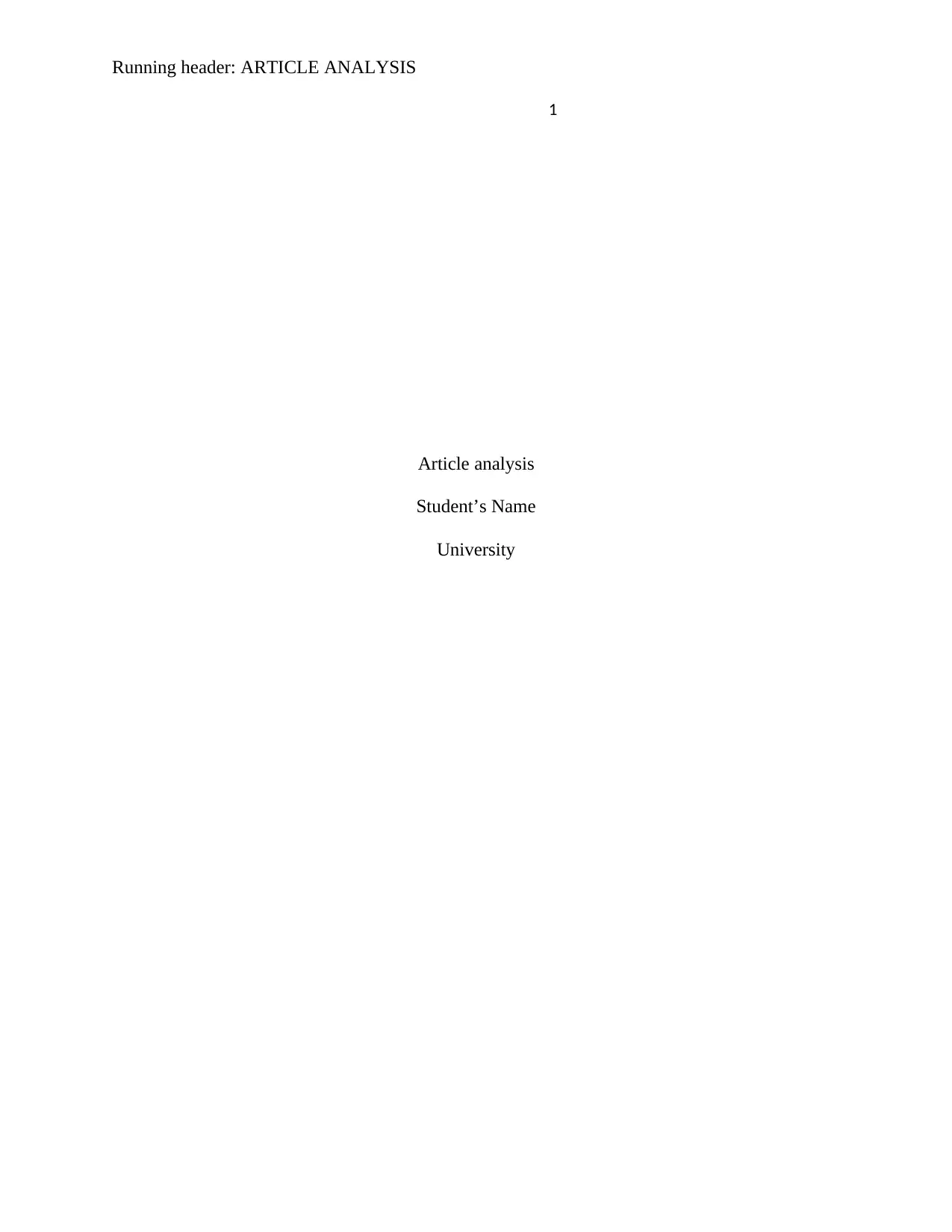
Running header: ARTICLE ANALYSIS
1
Article analysis
Student’s Name
University
1
Article analysis
Student’s Name
University
Secure Best Marks with AI Grader
Need help grading? Try our AI Grader for instant feedback on your assignments.
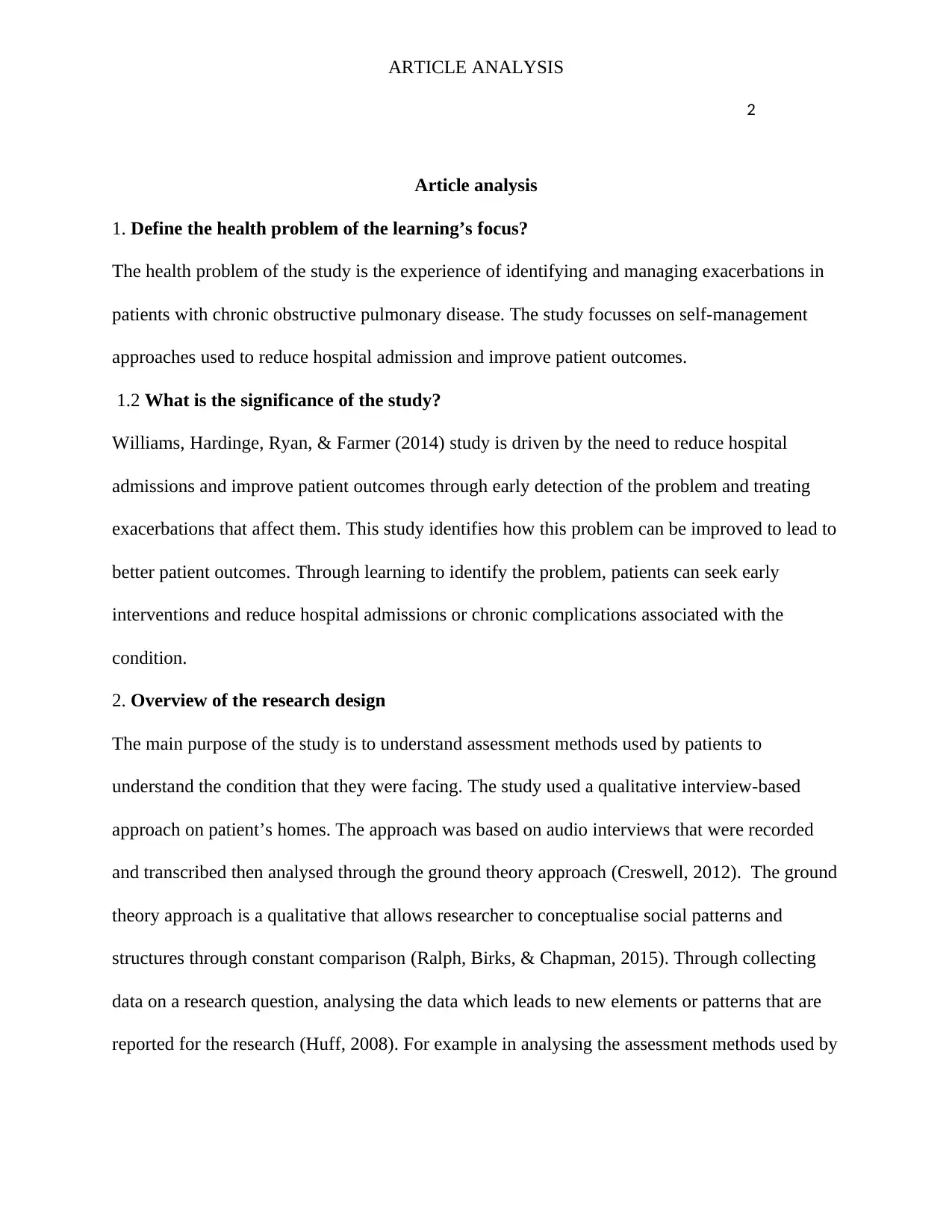
ARTICLE ANALYSIS
2
Article analysis
1. Define the health problem of the learning’s focus?
The health problem of the study is the experience of identifying and managing exacerbations in
patients with chronic obstructive pulmonary disease. The study focusses on self-management
approaches used to reduce hospital admission and improve patient outcomes.
1.2 What is the significance of the study?
Williams, Hardinge, Ryan, & Farmer (2014) study is driven by the need to reduce hospital
admissions and improve patient outcomes through early detection of the problem and treating
exacerbations that affect them. This study identifies how this problem can be improved to lead to
better patient outcomes. Through learning to identify the problem, patients can seek early
interventions and reduce hospital admissions or chronic complications associated with the
condition.
2. Overview of the research design
The main purpose of the study is to understand assessment methods used by patients to
understand the condition that they were facing. The study used a qualitative interview-based
approach on patient’s homes. The approach was based on audio interviews that were recorded
and transcribed then analysed through the ground theory approach (Creswell, 2012). The ground
theory approach is a qualitative that allows researcher to conceptualise social patterns and
structures through constant comparison (Ralph, Birks, & Chapman, 2015). Through collecting
data on a research question, analysing the data which leads to new elements or patterns that are
reported for the research (Huff, 2008). For example in analysing the assessment methods used by
2
Article analysis
1. Define the health problem of the learning’s focus?
The health problem of the study is the experience of identifying and managing exacerbations in
patients with chronic obstructive pulmonary disease. The study focusses on self-management
approaches used to reduce hospital admission and improve patient outcomes.
1.2 What is the significance of the study?
Williams, Hardinge, Ryan, & Farmer (2014) study is driven by the need to reduce hospital
admissions and improve patient outcomes through early detection of the problem and treating
exacerbations that affect them. This study identifies how this problem can be improved to lead to
better patient outcomes. Through learning to identify the problem, patients can seek early
interventions and reduce hospital admissions or chronic complications associated with the
condition.
2. Overview of the research design
The main purpose of the study is to understand assessment methods used by patients to
understand the condition that they were facing. The study used a qualitative interview-based
approach on patient’s homes. The approach was based on audio interviews that were recorded
and transcribed then analysed through the ground theory approach (Creswell, 2012). The ground
theory approach is a qualitative that allows researcher to conceptualise social patterns and
structures through constant comparison (Ralph, Birks, & Chapman, 2015). Through collecting
data on a research question, analysing the data which leads to new elements or patterns that are
reported for the research (Huff, 2008). For example in analysing the assessment methods used by
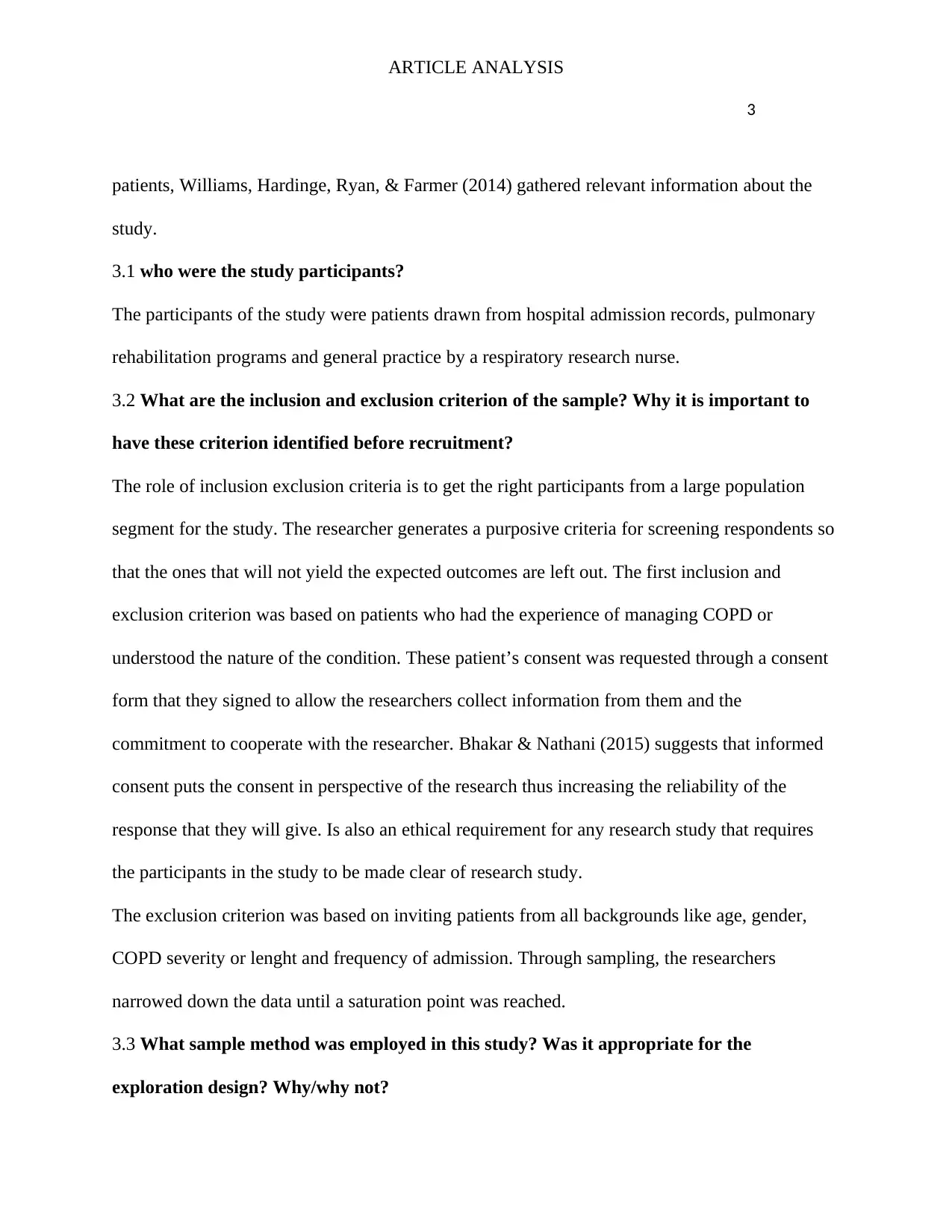
ARTICLE ANALYSIS
3
patients, Williams, Hardinge, Ryan, & Farmer (2014) gathered relevant information about the
study.
3.1 who were the study participants?
The participants of the study were patients drawn from hospital admission records, pulmonary
rehabilitation programs and general practice by a respiratory research nurse.
3.2 What are the inclusion and exclusion criterion of the sample? Why it is important to
have these criterion identified before recruitment?
The role of inclusion exclusion criteria is to get the right participants from a large population
segment for the study. The researcher generates a purposive criteria for screening respondents so
that the ones that will not yield the expected outcomes are left out. The first inclusion and
exclusion criterion was based on patients who had the experience of managing COPD or
understood the nature of the condition. These patient’s consent was requested through a consent
form that they signed to allow the researchers collect information from them and the
commitment to cooperate with the researcher. Bhakar & Nathani (2015) suggests that informed
consent puts the consent in perspective of the research thus increasing the reliability of the
response that they will give. Is also an ethical requirement for any research study that requires
the participants in the study to be made clear of research study.
The exclusion criterion was based on inviting patients from all backgrounds like age, gender,
COPD severity or lenght and frequency of admission. Through sampling, the researchers
narrowed down the data until a saturation point was reached.
3.3 What sample method was employed in this study? Was it appropriate for the
exploration design? Why/why not?
3
patients, Williams, Hardinge, Ryan, & Farmer (2014) gathered relevant information about the
study.
3.1 who were the study participants?
The participants of the study were patients drawn from hospital admission records, pulmonary
rehabilitation programs and general practice by a respiratory research nurse.
3.2 What are the inclusion and exclusion criterion of the sample? Why it is important to
have these criterion identified before recruitment?
The role of inclusion exclusion criteria is to get the right participants from a large population
segment for the study. The researcher generates a purposive criteria for screening respondents so
that the ones that will not yield the expected outcomes are left out. The first inclusion and
exclusion criterion was based on patients who had the experience of managing COPD or
understood the nature of the condition. These patient’s consent was requested through a consent
form that they signed to allow the researchers collect information from them and the
commitment to cooperate with the researcher. Bhakar & Nathani (2015) suggests that informed
consent puts the consent in perspective of the research thus increasing the reliability of the
response that they will give. Is also an ethical requirement for any research study that requires
the participants in the study to be made clear of research study.
The exclusion criterion was based on inviting patients from all backgrounds like age, gender,
COPD severity or lenght and frequency of admission. Through sampling, the researchers
narrowed down the data until a saturation point was reached.
3.3 What sample method was employed in this study? Was it appropriate for the
exploration design? Why/why not?
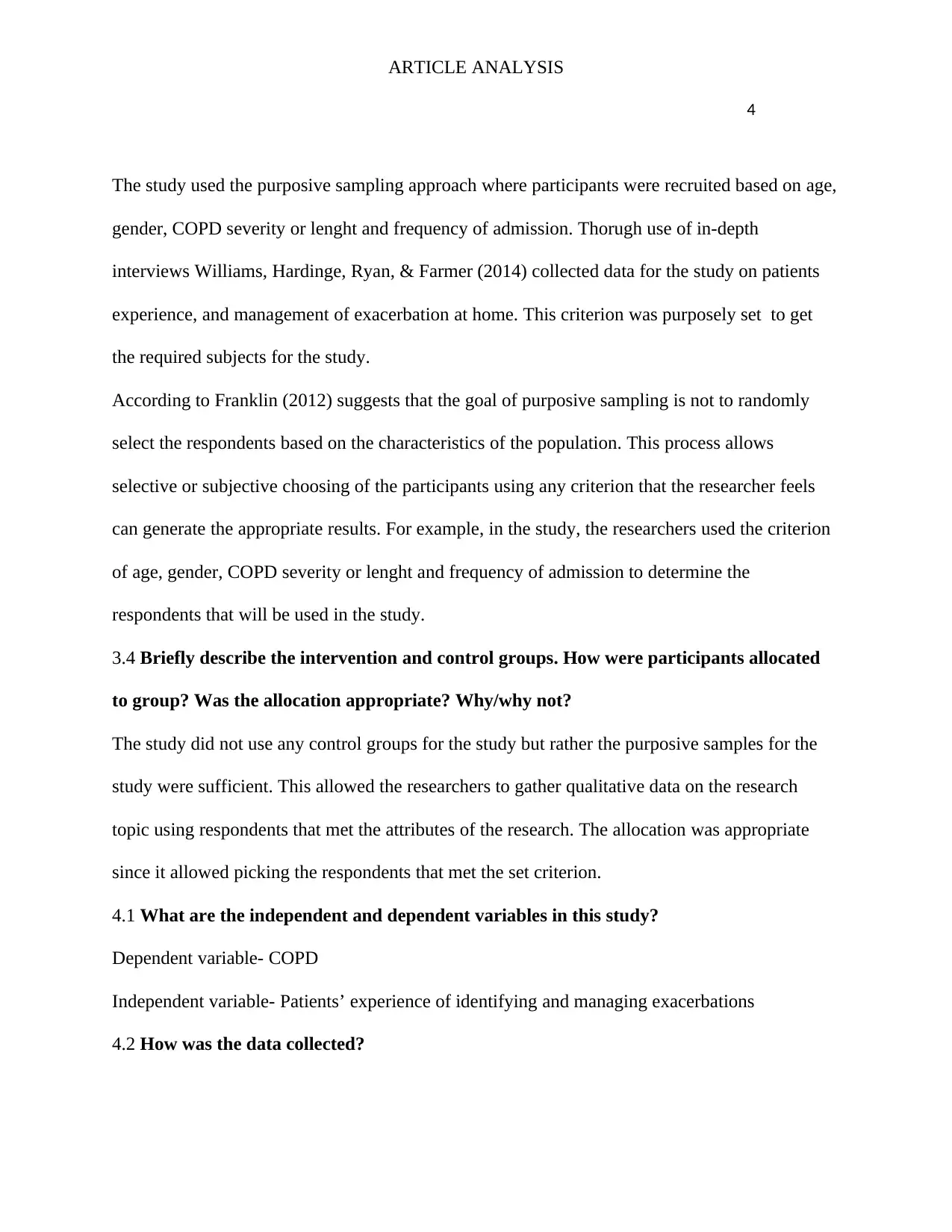
ARTICLE ANALYSIS
4
The study used the purposive sampling approach where participants were recruited based on age,
gender, COPD severity or lenght and frequency of admission. Thorugh use of in-depth
interviews Williams, Hardinge, Ryan, & Farmer (2014) collected data for the study on patients
experience, and management of exacerbation at home. This criterion was purposely set to get
the required subjects for the study.
According to Franklin (2012) suggests that the goal of purposive sampling is not to randomly
select the respondents based on the characteristics of the population. This process allows
selective or subjective choosing of the participants using any criterion that the researcher feels
can generate the appropriate results. For example, in the study, the researchers used the criterion
of age, gender, COPD severity or lenght and frequency of admission to determine the
respondents that will be used in the study.
3.4 Briefly describe the intervention and control groups. How were participants allocated
to group? Was the allocation appropriate? Why/why not?
The study did not use any control groups for the study but rather the purposive samples for the
study were sufficient. This allowed the researchers to gather qualitative data on the research
topic using respondents that met the attributes of the research. The allocation was appropriate
since it allowed picking the respondents that met the set criterion.
4.1 What are the independent and dependent variables in this study?
Dependent variable- COPD
Independent variable- Patients’ experience of identifying and managing exacerbations
4.2 How was the data collected?
4
The study used the purposive sampling approach where participants were recruited based on age,
gender, COPD severity or lenght and frequency of admission. Thorugh use of in-depth
interviews Williams, Hardinge, Ryan, & Farmer (2014) collected data for the study on patients
experience, and management of exacerbation at home. This criterion was purposely set to get
the required subjects for the study.
According to Franklin (2012) suggests that the goal of purposive sampling is not to randomly
select the respondents based on the characteristics of the population. This process allows
selective or subjective choosing of the participants using any criterion that the researcher feels
can generate the appropriate results. For example, in the study, the researchers used the criterion
of age, gender, COPD severity or lenght and frequency of admission to determine the
respondents that will be used in the study.
3.4 Briefly describe the intervention and control groups. How were participants allocated
to group? Was the allocation appropriate? Why/why not?
The study did not use any control groups for the study but rather the purposive samples for the
study were sufficient. This allowed the researchers to gather qualitative data on the research
topic using respondents that met the attributes of the research. The allocation was appropriate
since it allowed picking the respondents that met the set criterion.
4.1 What are the independent and dependent variables in this study?
Dependent variable- COPD
Independent variable- Patients’ experience of identifying and managing exacerbations
4.2 How was the data collected?
Secure Best Marks with AI Grader
Need help grading? Try our AI Grader for instant feedback on your assignments.
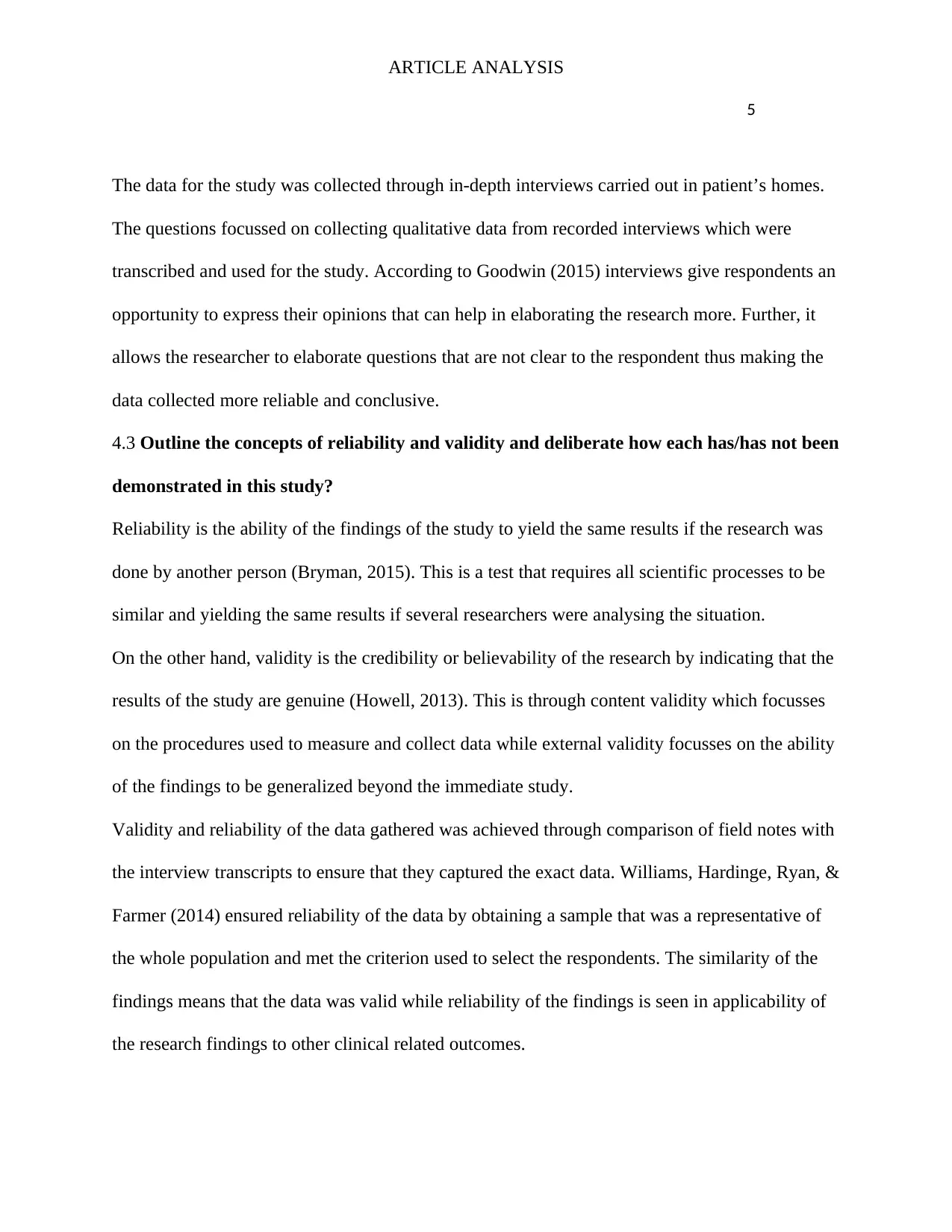
ARTICLE ANALYSIS
5
The data for the study was collected through in-depth interviews carried out in patient’s homes.
The questions focussed on collecting qualitative data from recorded interviews which were
transcribed and used for the study. According to Goodwin (2015) interviews give respondents an
opportunity to express their opinions that can help in elaborating the research more. Further, it
allows the researcher to elaborate questions that are not clear to the respondent thus making the
data collected more reliable and conclusive.
4.3 Outline the concepts of reliability and validity and deliberate how each has/has not been
demonstrated in this study?
Reliability is the ability of the findings of the study to yield the same results if the research was
done by another person (Bryman, 2015). This is a test that requires all scientific processes to be
similar and yielding the same results if several researchers were analysing the situation.
On the other hand, validity is the credibility or believability of the research by indicating that the
results of the study are genuine (Howell, 2013). This is through content validity which focusses
on the procedures used to measure and collect data while external validity focusses on the ability
of the findings to be generalized beyond the immediate study.
Validity and reliability of the data gathered was achieved through comparison of field notes with
the interview transcripts to ensure that they captured the exact data. Williams, Hardinge, Ryan, &
Farmer (2014) ensured reliability of the data by obtaining a sample that was a representative of
the whole population and met the criterion used to select the respondents. The similarity of the
findings means that the data was valid while reliability of the findings is seen in applicability of
the research findings to other clinical related outcomes.
5
The data for the study was collected through in-depth interviews carried out in patient’s homes.
The questions focussed on collecting qualitative data from recorded interviews which were
transcribed and used for the study. According to Goodwin (2015) interviews give respondents an
opportunity to express their opinions that can help in elaborating the research more. Further, it
allows the researcher to elaborate questions that are not clear to the respondent thus making the
data collected more reliable and conclusive.
4.3 Outline the concepts of reliability and validity and deliberate how each has/has not been
demonstrated in this study?
Reliability is the ability of the findings of the study to yield the same results if the research was
done by another person (Bryman, 2015). This is a test that requires all scientific processes to be
similar and yielding the same results if several researchers were analysing the situation.
On the other hand, validity is the credibility or believability of the research by indicating that the
results of the study are genuine (Howell, 2013). This is through content validity which focusses
on the procedures used to measure and collect data while external validity focusses on the ability
of the findings to be generalized beyond the immediate study.
Validity and reliability of the data gathered was achieved through comparison of field notes with
the interview transcripts to ensure that they captured the exact data. Williams, Hardinge, Ryan, &
Farmer (2014) ensured reliability of the data by obtaining a sample that was a representative of
the whole population and met the criterion used to select the respondents. The similarity of the
findings means that the data was valid while reliability of the findings is seen in applicability of
the research findings to other clinical related outcomes.
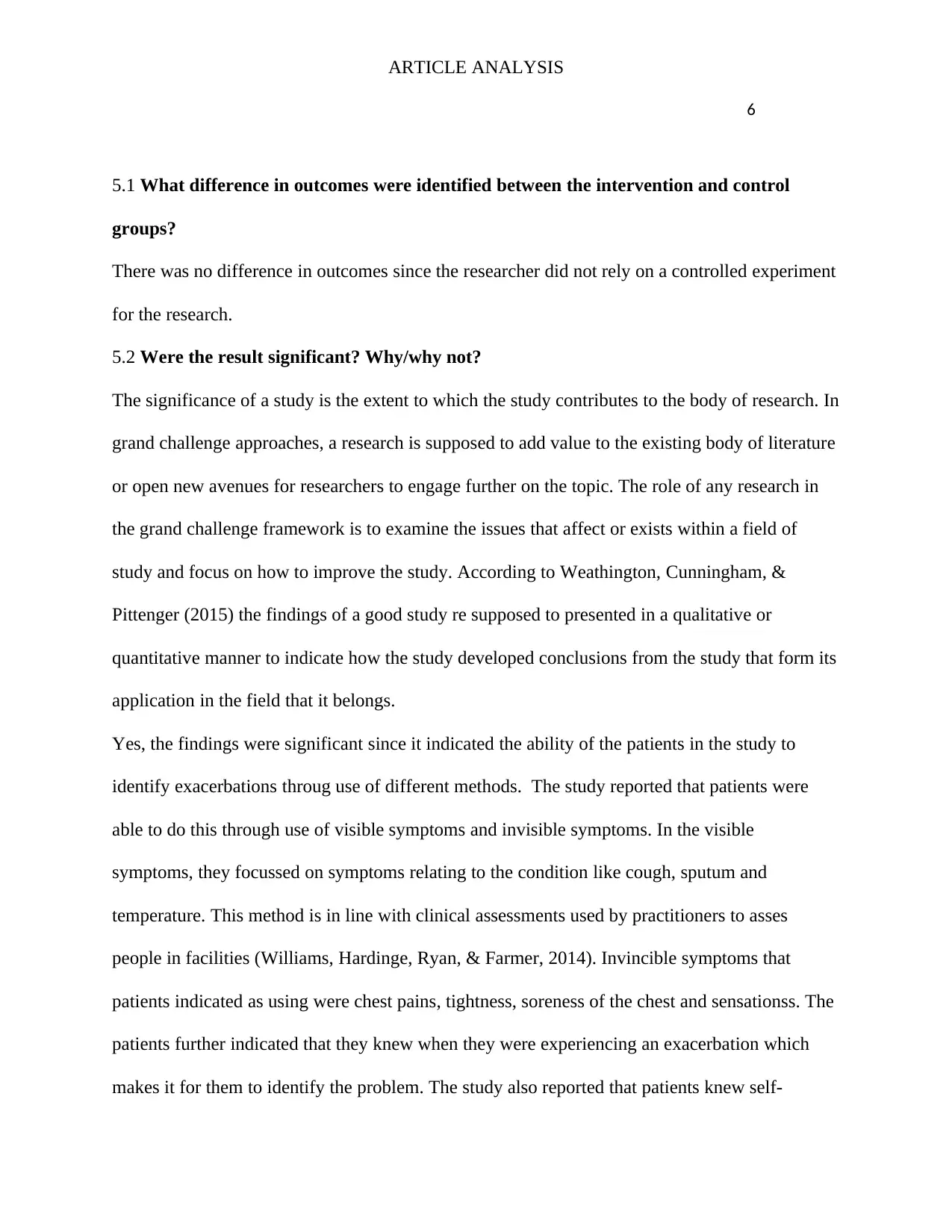
ARTICLE ANALYSIS
6
5.1 What difference in outcomes were identified between the intervention and control
groups?
There was no difference in outcomes since the researcher did not rely on a controlled experiment
for the research.
5.2 Were the result significant? Why/why not?
The significance of a study is the extent to which the study contributes to the body of research. In
grand challenge approaches, a research is supposed to add value to the existing body of literature
or open new avenues for researchers to engage further on the topic. The role of any research in
the grand challenge framework is to examine the issues that affect or exists within a field of
study and focus on how to improve the study. According to Weathington, Cunningham, &
Pittenger (2015) the findings of a good study re supposed to presented in a qualitative or
quantitative manner to indicate how the study developed conclusions from the study that form its
application in the field that it belongs.
Yes, the findings were significant since it indicated the ability of the patients in the study to
identify exacerbations throug use of different methods. The study reported that patients were
able to do this through use of visible symptoms and invisible symptoms. In the visible
symptoms, they focussed on symptoms relating to the condition like cough, sputum and
temperature. This method is in line with clinical assessments used by practitioners to asses
people in facilities (Williams, Hardinge, Ryan, & Farmer, 2014). Invincible symptoms that
patients indicated as using were chest pains, tightness, soreness of the chest and sensationss. The
patients further indicated that they knew when they were experiencing an exacerbation which
makes it for them to identify the problem. The study also reported that patients knew self-
6
5.1 What difference in outcomes were identified between the intervention and control
groups?
There was no difference in outcomes since the researcher did not rely on a controlled experiment
for the research.
5.2 Were the result significant? Why/why not?
The significance of a study is the extent to which the study contributes to the body of research. In
grand challenge approaches, a research is supposed to add value to the existing body of literature
or open new avenues for researchers to engage further on the topic. The role of any research in
the grand challenge framework is to examine the issues that affect or exists within a field of
study and focus on how to improve the study. According to Weathington, Cunningham, &
Pittenger (2015) the findings of a good study re supposed to presented in a qualitative or
quantitative manner to indicate how the study developed conclusions from the study that form its
application in the field that it belongs.
Yes, the findings were significant since it indicated the ability of the patients in the study to
identify exacerbations throug use of different methods. The study reported that patients were
able to do this through use of visible symptoms and invisible symptoms. In the visible
symptoms, they focussed on symptoms relating to the condition like cough, sputum and
temperature. This method is in line with clinical assessments used by practitioners to asses
people in facilities (Williams, Hardinge, Ryan, & Farmer, 2014). Invincible symptoms that
patients indicated as using were chest pains, tightness, soreness of the chest and sensationss. The
patients further indicated that they knew when they were experiencing an exacerbation which
makes it for them to identify the problem. The study also reported that patients knew self-
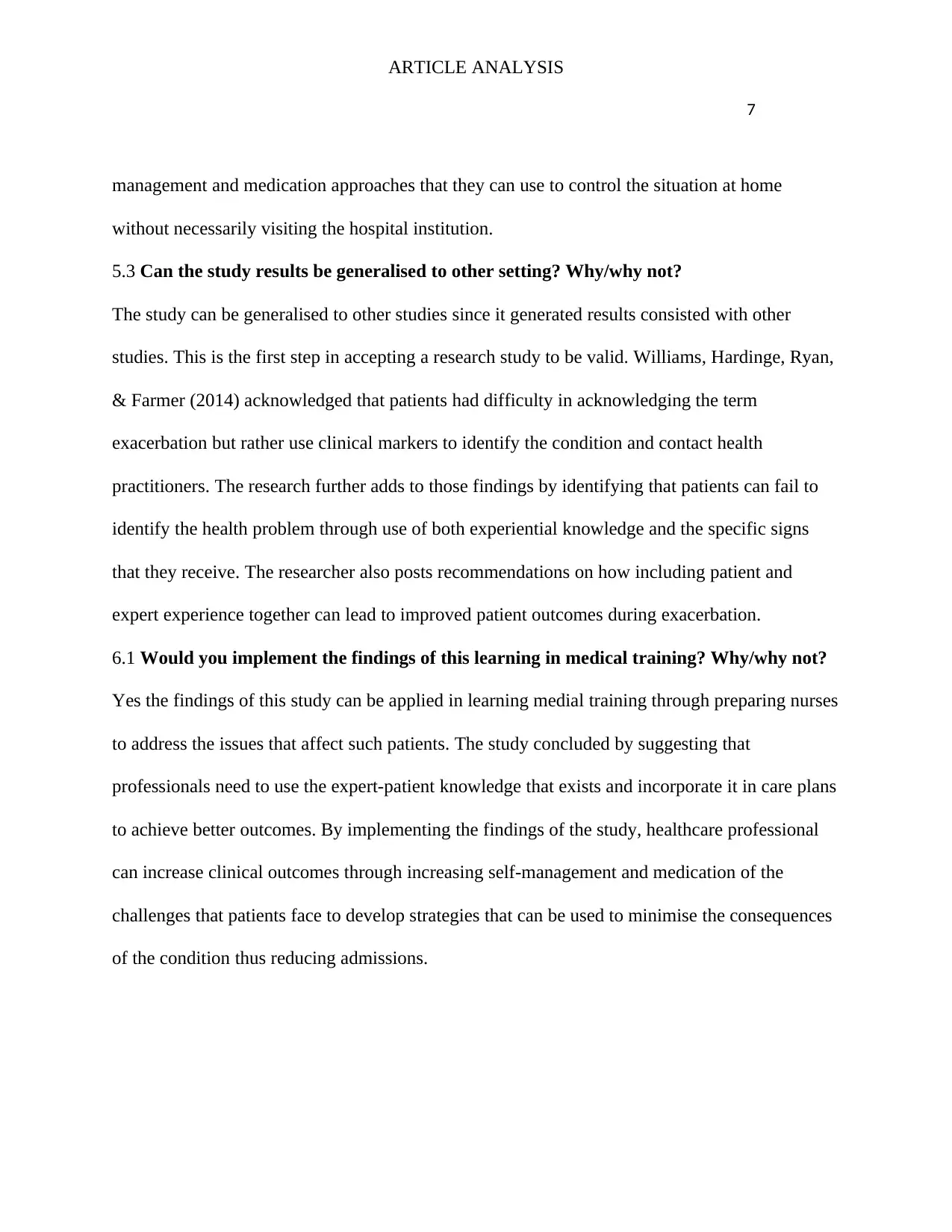
ARTICLE ANALYSIS
7
management and medication approaches that they can use to control the situation at home
without necessarily visiting the hospital institution.
5.3 Can the study results be generalised to other setting? Why/why not?
The study can be generalised to other studies since it generated results consisted with other
studies. This is the first step in accepting a research study to be valid. Williams, Hardinge, Ryan,
& Farmer (2014) acknowledged that patients had difficulty in acknowledging the term
exacerbation but rather use clinical markers to identify the condition and contact health
practitioners. The research further adds to those findings by identifying that patients can fail to
identify the health problem through use of both experiential knowledge and the specific signs
that they receive. The researcher also posts recommendations on how including patient and
expert experience together can lead to improved patient outcomes during exacerbation.
6.1 Would you implement the findings of this learning in medical training? Why/why not?
Yes the findings of this study can be applied in learning medial training through preparing nurses
to address the issues that affect such patients. The study concluded by suggesting that
professionals need to use the expert-patient knowledge that exists and incorporate it in care plans
to achieve better outcomes. By implementing the findings of the study, healthcare professional
can increase clinical outcomes through increasing self-management and medication of the
challenges that patients face to develop strategies that can be used to minimise the consequences
of the condition thus reducing admissions.
7
management and medication approaches that they can use to control the situation at home
without necessarily visiting the hospital institution.
5.3 Can the study results be generalised to other setting? Why/why not?
The study can be generalised to other studies since it generated results consisted with other
studies. This is the first step in accepting a research study to be valid. Williams, Hardinge, Ryan,
& Farmer (2014) acknowledged that patients had difficulty in acknowledging the term
exacerbation but rather use clinical markers to identify the condition and contact health
practitioners. The research further adds to those findings by identifying that patients can fail to
identify the health problem through use of both experiential knowledge and the specific signs
that they receive. The researcher also posts recommendations on how including patient and
expert experience together can lead to improved patient outcomes during exacerbation.
6.1 Would you implement the findings of this learning in medical training? Why/why not?
Yes the findings of this study can be applied in learning medial training through preparing nurses
to address the issues that affect such patients. The study concluded by suggesting that
professionals need to use the expert-patient knowledge that exists and incorporate it in care plans
to achieve better outcomes. By implementing the findings of the study, healthcare professional
can increase clinical outcomes through increasing self-management and medication of the
challenges that patients face to develop strategies that can be used to minimise the consequences
of the condition thus reducing admissions.
Paraphrase This Document
Need a fresh take? Get an instant paraphrase of this document with our AI Paraphraser
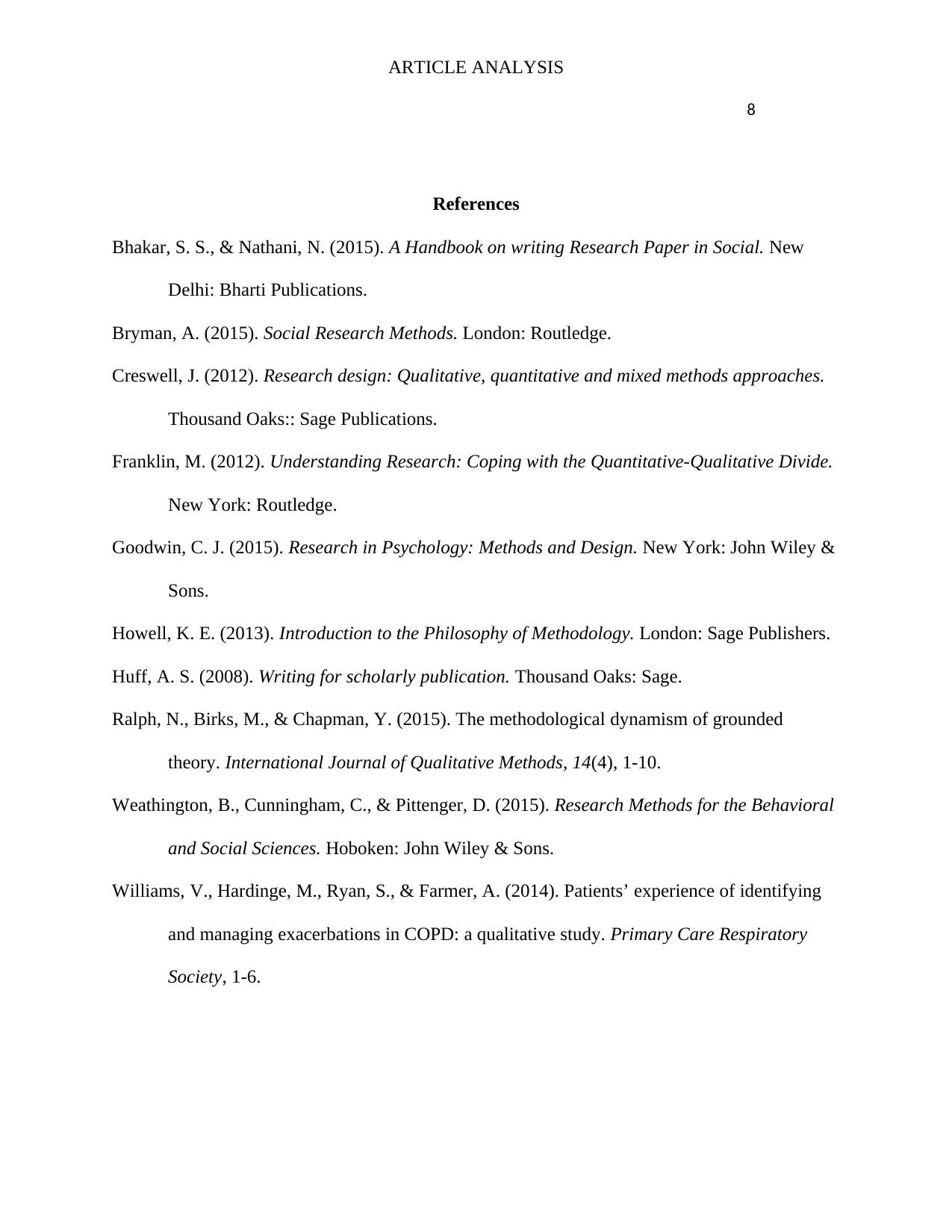
ARTICLE ANALYSIS
8
References
Bhakar, S. S., & Nathani, N. (2015). A Handbook on writing Research Paper in Social. New
Delhi: Bharti Publications.
Bryman, A. (2015). Social Research Methods. London: Routledge.
Creswell, J. (2012). Research design: Qualitative, quantitative and mixed methods approaches.
Thousand Oaks:: Sage Publications.
Franklin, M. (2012). Understanding Research: Coping with the Quantitative-Qualitative Divide.
New York: Routledge.
Goodwin, C. J. (2015). Research in Psychology: Methods and Design. New York: John Wiley &
Sons.
Howell, K. E. (2013). Introduction to the Philosophy of Methodology. London: Sage Publishers.
Huff, A. S. (2008). Writing for scholarly publication. Thousand Oaks: Sage.
Ralph, N., Birks, M., & Chapman, Y. (2015). The methodological dynamism of grounded
theory. International Journal of Qualitative Methods, 14(4), 1-10.
Weathington, B., Cunningham, C., & Pittenger, D. (2015). Research Methods for the Behavioral
and Social Sciences. Hoboken: John Wiley & Sons.
Williams, V., Hardinge, M., Ryan, S., & Farmer, A. (2014). Patients’ experience of identifying
and managing exacerbations in COPD: a qualitative study. Primary Care Respiratory
Society, 1-6.
8
References
Bhakar, S. S., & Nathani, N. (2015). A Handbook on writing Research Paper in Social. New
Delhi: Bharti Publications.
Bryman, A. (2015). Social Research Methods. London: Routledge.
Creswell, J. (2012). Research design: Qualitative, quantitative and mixed methods approaches.
Thousand Oaks:: Sage Publications.
Franklin, M. (2012). Understanding Research: Coping with the Quantitative-Qualitative Divide.
New York: Routledge.
Goodwin, C. J. (2015). Research in Psychology: Methods and Design. New York: John Wiley &
Sons.
Howell, K. E. (2013). Introduction to the Philosophy of Methodology. London: Sage Publishers.
Huff, A. S. (2008). Writing for scholarly publication. Thousand Oaks: Sage.
Ralph, N., Birks, M., & Chapman, Y. (2015). The methodological dynamism of grounded
theory. International Journal of Qualitative Methods, 14(4), 1-10.
Weathington, B., Cunningham, C., & Pittenger, D. (2015). Research Methods for the Behavioral
and Social Sciences. Hoboken: John Wiley & Sons.
Williams, V., Hardinge, M., Ryan, S., & Farmer, A. (2014). Patients’ experience of identifying
and managing exacerbations in COPD: a qualitative study. Primary Care Respiratory
Society, 1-6.
1 out of 8
Related Documents
Your All-in-One AI-Powered Toolkit for Academic Success.
+13062052269
info@desklib.com
Available 24*7 on WhatsApp / Email
![[object Object]](/_next/static/media/star-bottom.7253800d.svg)
Unlock your academic potential
© 2024 | Zucol Services PVT LTD | All rights reserved.



